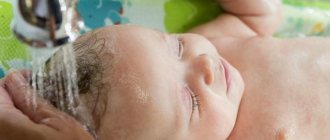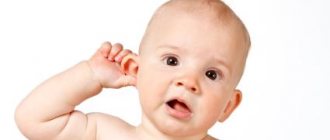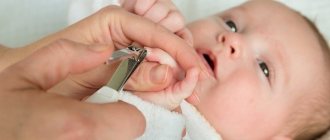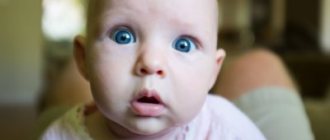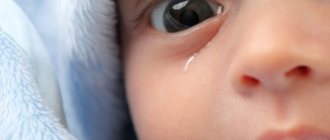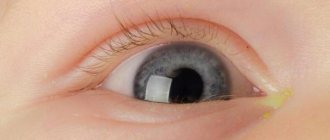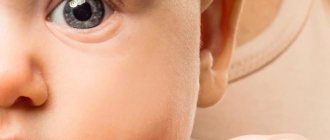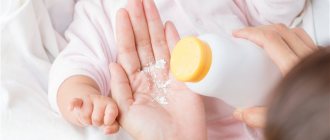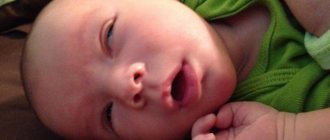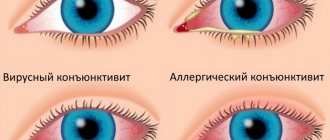Morning wash
Every new morning you need to start with washing your face.
To wash your baby, place a bowl of boiled water nearby and wipe the baby’s face with a moistened cotton swab, and then pat it dry with a clean diaper. Don't forget to wipe the neck folds too. If the skin on your cheeks is still peeling, lubricate it with baby cream after washing.
There are special devices for washing the nose, eyes, and ears - turundas. Moms don’t have to go to great lengths to make cotton or gauze wicks - just go to any pharmacy and buy these easy-to-use devices. It’s too early to use cotton swabs - they can damage the baby’s delicate skin.
Eyes
Let's soak such a turd in water and carefully run it over the closed eyelids of the little one - from the temple to the nose. First one eye, then the second.
It is in this direction that the eyes clean themselves with the help of tear fluid. If you notice mucous discharge, start rinsing with the healthy eye to prevent infection. Tell your pediatrician if you notice any discharge.
Nose, ears
To clean the nose, take a dry turunda, carefully insert it into the nasal passage, turn clockwise approximately 360 degrees 1 or 2 times and remove the turunda. This will remove any accumulated mucus. Do the same with the second nasal passage. If crusts have formed in your nose, then moisten the swab with cosmetic oil and soften them for 2-3 minutes.
Using the next clean and dry flagellum, remove any remaining crusts.
The child’s ears should be cleaned in the morning as needed, but you can also do this after bathing to remove excess moisture at the same time. To do this, just leave the swabs in your ears for a couple of minutes.
Washing
Babies should be washed with warm running water after each bowel movement.
Take the child under the arms so that his tummy rests on your hand, and with the other hand hold his back and carry him straight to the bathroom. Turn on the tap so the water is warm and put some baby bath gel on your hand. However, it is not at all necessary to use a gel or other cosmetic product, especially if the baby is prone to allergies.
Due to the anatomical structure of the organs of the genitourinary system, girls are washed from front to back, and boys - in any direction. And don’t be afraid - the little one really likes this hanging position on his mother’s hand.
After washing, dry the baby with a soft towel, paying special attention to the folds on the legs, but do not rush to change the diaper. It is very useful to give your child an air bath for several minutes after each wash. Especially if he is in a good mood.
A newborn's eye becomes sour - what to do, treatment and prevention
Any parent is vigilant about the condition of the newborn. And this, as many people think, is unnecessary care, is actually a necessary thing in caring for a baby. Since the baby is not able to explain where and how it hurts, and can only cry, parents must be able to notice any problem in time.
If the baby's eye starts to turn sour, his mother will definitely notice it. However, not everyone knows how to cope with such a problem and begin to resort to traditional medicine on the advice of their grandmothers.
Unfortunately, such actions can lead to unpleasant consequences, even leading to serious visual impairment.
What does the term “sour eye” mean?
In fact, the concept of “sour eyes” hides several symptoms at once, namely:
- Redness of both the eyeball itself and, in some cases, the skin around it;
- Tears or pus are released from the eyes during sleep; these secretions dry out into a crust, making it difficult for the eyes to open;
- The eyes and eyelids swell greatly.
There are cases when, in addition to the three main signs: redness of the eyes, regular discharge and swelling, an elevated temperature is added.
Symptoms of nitrous eyes in a baby
There are a number of signs that can tell parents that they are experiencing eye soreness:
- Because of the crust that appears at night, it is difficult for the baby to open his eyes;
- Mucus accumulates overnight and as soon as the baby manages to open his eyelids, it covers the entire part of the eyeball;
- The baby, unlike older children who may complain of burning and pain, begins to cry;
- To get rid of pain and burning, the baby constantly rubs his eyes;
- The secreted mucus can have different shades from light yellow to brown;
- After the eyes are cleaned, after 30 minutes the mucus begins to accumulate again.
Regardless of age, children begin to be capricious, lose their appetite, sleep anxiously, and often become irritable. The baby has a hard time with this disease, causing difficulties for the parents as well.
But before you treat oxide eyes, it is necessary to identify the causes.
What causes sour eyes in babies?
In children, souring of the eyes occurs for the same reasons as in an adult - conjunctivitis, the formation of which also has several reasons:
- Viruses. For infants, this cause is the rarest. The most common viral disease is conjunctivitis, which can be determined by the absence of pus discharge. Children become infected with viral conjunctivitis most often in unventilated areas during outbreaks of ARVI;
- Allergy. Allergic conjunctivitis occurs in children with allergies when interacting with an allergen. Unlike viral conjunctiva, allergic conjunctiva proceeds somewhat differently - swelling appears, but there are no symptoms of a cold. The disease will subside the moment allergens disappear around the child;
- Bacteria. Most often, sour eyes occur precisely for this reason. The main sign that the cause of the disease is bacteria - greenish-yellow discharge. In some cases, signs of a cold and severe swelling appear.
If we talk about an adult, then nitrous eyes are more likely to occur due to viruses, but in children, bacterial damage most often occurs. This is due to the fact that children touch everything and then touch their eyes with their hands. And since bacteria are found absolutely everywhere, it’s no wonder that babies get them into their eyes so quickly.
Another cause of nitrous eyes is dacryocystitis. Conjunctivitis is much more common than this disease. But it is considered more terrible.
Only a specialist will be able to make the correct diagnosis and determine what exactly caused the disease. If the correct treatment is not prescribed in time, complications may occur. Parents should trust doctors and not self-medicate.
One of the diseases that can cause nitrous eye is Staphylococcus aureus. This disease can begin in the maternity ward. The infection could be transmitted to the newborn both through the mother and through medical workers.
This is due to the fact that it is easy for bacteria to multiply in the eyes of a newly born child, because his immunity is practically not developed.
Symptoms of Staphylococcus aureus include purulent discharge that forms crusts around the eyes, as well as high photosensitivity of the eyes.
Treatment for nitrous eyes
Treatment is prescribed by a doctor after he has determined the cause of the disease:
- When it comes to viruses and bacteria, the main task is to keep the eye clean. To achieve this, you need to wipe your eyes with a cotton pad soaked in a special decoction;
- In cases where the souring of the eye occurs due to allergies, first of all it is necessary to eliminate all allergens. At home, be sure to carry out a wet cleaning in all rooms and, if possible, relocate pets for a while until the allergy goes away. In addition, the baby needs to constantly wipe his eyes.
In cases where a child has dacryocystitis, the treatment will be slightly different:
- The eye, as in other cases, must be wiped with a solution;
- The baby will also need to massage the tear duct area.
If you consult a doctor right away, treatment will be quick, and the disease will subside in a maximum of a week. In advanced cases, the doctor may prescribe antibiotic treatment.
There are situations when treatment does not bring results, then the newborn’s eyes (namely the tear duct) will be cleaned by specialists in the hospital. This procedure is easy to carry out, and the baby will immediately feel better.
Your doctor may prescribe different types of medications:
- Antiseptic. This type of medicine is used to get rid of bacteria. Most often, doctors prescribe Miramistin;
- Eye drops or ointments against the virus. They are prescribed in cases where the eyes are inflamed due to viral diseases;
- Antibacterial ointments or drops. These medications can be used from the first days of a child’s life.
Eye treatment procedure
If a baby's eye becomes sour, they need to be treated with special treatment. solution, for example, an antiseptic:
- Before treating your baby’s eyes, you need to thoroughly wash your hands and also treat them with a special product;
- The newborn must be swaddled and placed in front of you;
- The eyes are treated with a solution from the outer to the inner corner. It is very important to use clean cotton pads for each eye. Otherwise, the procedure will not only not bring any benefit, but will also aggravate the situation;
- If the doctor has prescribed medicine or drops, then before using them, it is necessary to slightly move the baby’s lower eyelid;
- Let the baby blink so that the medicine is distributed throughout the eye;
- We clean with a cotton swab or napkin to remove excess medicine.
Most often, medicines are stored in the refrigerator; before using them, you need to warm them a little in your palms so as not to cause discomfort to the baby. Remember that only your doctor can tell you which medicine to use.
Is it possible to walk with a newborn if he has a sour eye?
It is very important to follow the instructions of specialists when treating a baby’s eye, namely, to go outside no earlier than an hour after treating the eyes.
Walking time will have to be reduced, and you can only go outside in warm and calm weather. If you go out with your newborn for a walk in the cold or rain, there is a high probability that the disease will only get worse. During illness, it will be enough for the baby to stay in a well-ventilated area.
After each walk, you must immediately repeat the eye treatment procedure.
Evening swimming
After discharge from the hospital and the umbilical wound has healed, the baby can be bathed. During the first month, you need to bathe the child every day, and then - depending on the condition of the baby and parents - every other day or even a little less often.
Currently, doctors advise using warm water straight from the tap (do not boil).
Water temperature
The temperature should be from 33 to 37 degrees, no more. Here you need to look at the baby’s well-being - slightly cooler water will stimulate him to move and be active, and above 35 degrees will relax and calm him down.
To measure temperature, choose an alcohol thermometer, which can be kept in the bath constantly during bathing. This will allow you to control the water temperature. The thermometer must be protected by a plastic case.
Bathing products
Once a week you need to wash your baby using baby bath products. It doesn’t have to be baby soap; you can use foams, gels, and shampoos. It makes no sense to abandon the achievements of progress and return completely to the methods of our grandmothers - herbal decoctions.
This can be resorted to only in certain cases - if the newborn has heat rash, irritation or diaper rash. Decoctions of string, chamomile, and lavender are very beneficial for the skin. It is no longer recommended to add potassium permanganate solution to water. This is due to the mass allerization of the population.
For swimming you will need:
- Bath;
- Soap, gel or others;
- Ladle;
- Soft towel;
- Natural sponge;
- Baby oil, powder;
- Clean clothes to change into.
Bathing process step by step
- Make sure the water temperature is normal. Supporting the baby’s hips and buttocks with one hand, and the head and shoulders with the other, carefully lower him into the water;
- Release the hand that was supporting the hips and immerse the child in the water up to shoulder level. Lather the body, starting from the folds of the neck, behind the ears and beyond;
- Apply a few drops of shampoo to the head and massage, rinse off the foam from the face to the back of the head;
- Supporting the baby's chest with your hand, carefully turn the baby onto his tummy and wash his back and butt;
- Use warm water prepared in advance from a ladle to rinse off any remaining soap. Holding the shoulders and buttocks, remove the baby from the bath;
- Dry the entire body, folds, head with a fluffy terry towel;
- If necessary (skin peeling, prickly heat, diaper rash), apply a cosmetic product to the child’s skin - it can be baby cream, talc, etc.;
- After 2-3 minutes of taking an air bath and drying, put on clean underwear.
Prevention of eye inflammation in a newborn
The most common drugs for the prevention of inflammation of the organs of vision in infants are a solution of Furacilin and sodium chloride, as well as decoctions of medicinal plants.
Eye treatment with Furacilin
Furacilin is an antimicrobial drug for external use that is effective against streptococci, staphylococci, E. coli, salmonella, and dysentery bacilli. It is produced in the form of ready-made solutions or tablets, from which you need to prepare the product yourself. For newborn babies, it is recommended to use a pharmaceutical solution as it is more sterile.
The drug Furacilin has been effectively used in medicine for more than one generation, since bacterial resistance to the substance develops slowly
Before using Furacilin, you should consult your pediatrician, since it is not effective for all eye diseases in infants. Thus, the use of the drug is completely in vain for allergic conjunctivitis.
Video: how to dilute a Furacilin tablet
Saline eye wash
Saline solution is a solution of sodium chloride salt at a concentration of 0.9%, the osmotic pressure of which is similar to that in blood plasma.
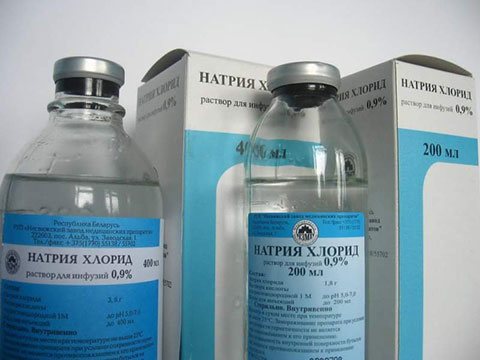
Saline solution is a good way to clean and rinse the eyes of a newborn.
The saline solution does not cause any harm to the baby and does not cause discomfort when applied to the mucous membranes. The advantages of using this product are obvious:
- saline solution is non-allergic;
- does not cause irritation;
- sold ready-made;
- costs less than its analogues.
This product is mainly used to wash the eyes of a newborn in order to mechanically clean them of dust or flying debris. If signs of bacterial conjunctivitis appear, treatment with saline solution alone is not enough; it is most suitable for baby hygiene.
Phytotherapy
As auxiliary anti-inflammatory drugs, you can use decoctions and infusions of herbs for washing and preparing compresses. It should be remembered that these remedies do not help with inflammation caused by blockage of the tear ducts, but are effective for conjunctivitis.
Black tea compress
One of the most common and well-known remedies for suppuration of the eyes is a compress of strong black tea, which relieves irritation and soothes the baby’s delicate skin.
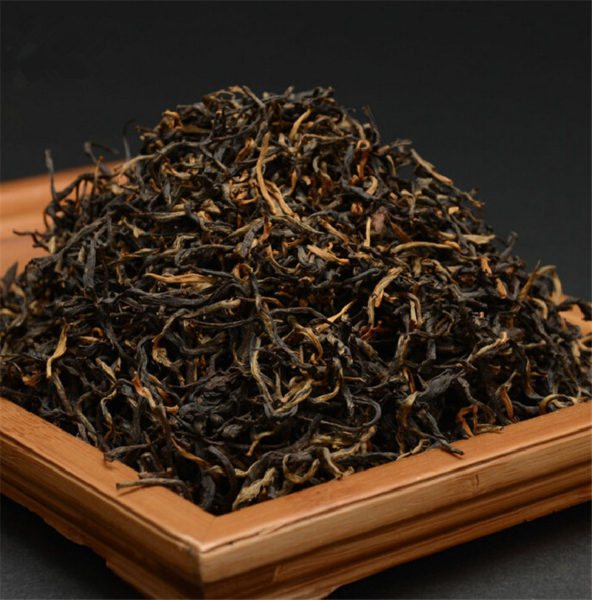
Anti-inflammatory properties of tea can be used in the fight against conjunctivitis
Preparation of the compress:
- Take loose-leaf black tea that does not contain artificial colors, flavors or other additives.
- Brew strong tea and cool it to room temperature (to do this, leave it to steep for half an hour).
- Strain the tea from the brew.
- Soak cotton pads in the prepared tea, squeeze lightly and apply to eyes for 10 minutes.
If the baby is afraid of the compress and shows severe anxiety, you can simply wipe the eyes with tea 2 times a day until the symptoms of eye suppuration disappear.
Camomile tea
Pharmaceutical chamomile is known for its ability to relieve inflammatory processes. An infusion of flowers can be used to wash your baby’s eyes to prevent and eliminate eye suppuration.
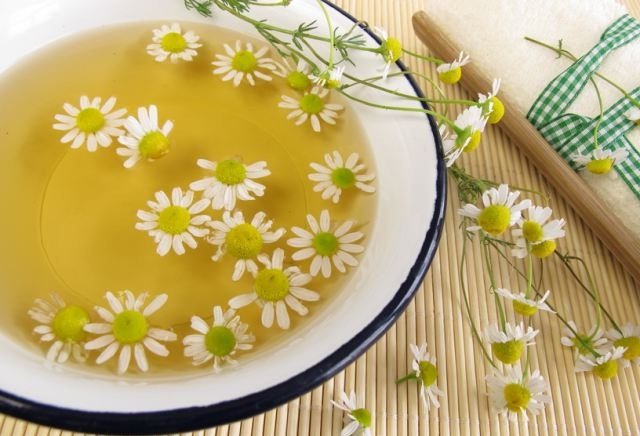
Chamomile has long been used as an anti-inflammatory, hemostatic agent, and also in the treatment of various diseases.
Preparation of the infusion:
- Take 4 tablespoons of chamomile and brew with a glass of boiling water.
- Infuse the flowers for an hour.
- Strain the infusion.
Rinsing the baby's eyes should be done in the morning and evening during hygiene procedures.
Calendula decoction
Calendula is effective against inflammatory eye diseases, especially purulent ones.
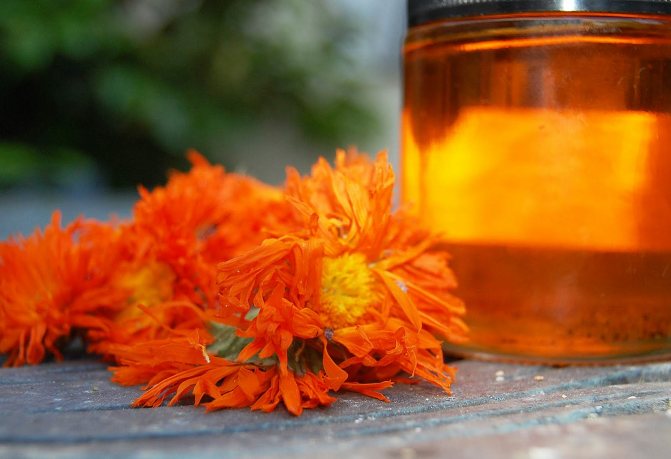
Calendula has been used in folk medicine for many years as an excellent antiseptic.
Preparation of decoction for washing eyes:
- Place a tablespoon of calendula flowers in a saucepan and add a glass of boiling water.
- Boil the flowers for 10 minutes.
- Cool the broth and strain through cheesecloth.
The finished product can be used as compresses, as well as for washing the eyes after sleep until recovery.
Despite the fact that calendula is a weak allergen, before washing the eyes of a newborn, it is worth doing a preliminary test to check the reaction on the skin in the elbow area.
Eye wash for conjunctivitis
Regardless of the nature of the disease, the symptoms of conjunctivitis boil down to several main ones:
- sensation of a foreign body in the eye;
- increased discomfort in bright lighting;
- lacrimation;
- redness of the inflamed mucous membrane of the eye;
- swelling and swelling of the eyelids;
- the appearance of pus and mucus in the eyes;
- sticking of the eyelids after the baby sleeps for a long time (the so-called souring of the child’s eyes).
Bacterial conjunctivitis differs from viral conjunctivitis in the frequent sticking of eyelashes, while the allergic nature of the disease reveals itself by excessive itching and watery eyes. More often, pathology manifests itself in premature babies.
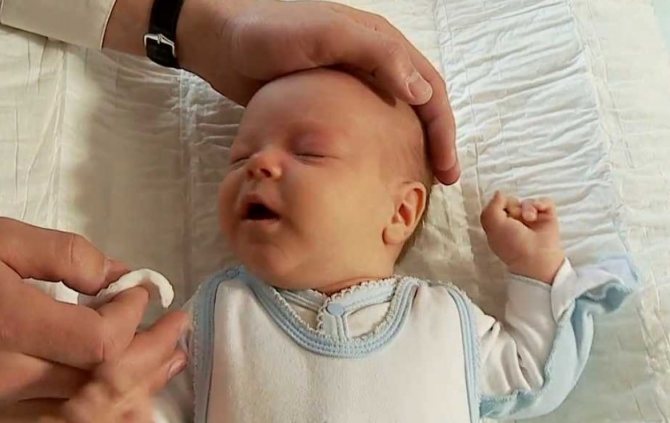
Washing the eyes helps reduce the number of pathogens and wash away their metabolic products from the mucous membrane of the organs of vision.
The prescription of therapy should be carried out by the attending physician depending on what type of disease is detected in the baby. Having determined the nature of conjunctivitis, the doctor selects drugs with a specific mechanism of action.
When treating the disease, a special place is given to washing the eyelids and conjunctiva, that is, directly to the hygiene of the eyes of a newborn. Suitable means for this are:
- Furacilin solution;
- saline;
- tea leaves;
- decoctions and infusions of herbs with anti-inflammatory effects;
- Albucid 10% solution is an antibiotic used in infants if rinsing with antiseptic solutions is ineffective.
Video: Doctor Komarovsky about conjunctivitis and its treatment
Duration of bathing and aids
The first bath should last no more than 5 minutes. Then, as your child gets older, you can increase this time by 3-5 minutes per week or more. If your baby likes this procedure, it won’t hurt him at all (provided you do everything correctly and follow the doctor’s recommendations).
Children's stores now offer many devices for the safety and comfort of children when bathing: suction beds, hammocks, support rings and much more.
It is better to start using them a little later - after two months, especially for inexperienced parents. And from the first days, the most reliable protection for a little one should be mother’s and father’s affectionate hands.
What to do if your baby's eyes are infected
In many newborns, approximately on the 3rd day after birth, pus begins to accumulate in the eyes and the eyelids stick together. These are signs of conjunctivitis, which very often appears after childbirth. The disease is not considered complex, does not have a negative effect on the baby’s vision and is easily treated with special antibiotic drops that any pediatrician can prescribe. However, treatment must be carried out without fail to stop the spread of infection.
After approximately 3 days of treatment, all symptoms should disappear. At the same time, parents should remember that drops must be instilled into both eyes , even if only one is festering. This can prevent the infection from spreading to the healthy eye.
There are cases when the infection, even with appropriate treatment, does not go away or even begins to develop. Also, the appearance of pus may resume a few days after treatment. Sometimes purulent discharge is accompanied by lacrimation, which indicates blockage of the tear ducts. In these cases, you should consult an ophthalmologist. Self-medication in this case is contraindicated.
Do not forget that daily bathing does not replace the procedure of washing the eyes. It must be performed daily, at least 2 times a day. It will be possible to cancel it only when the baby begins to bathe like an adult and the eyes will be washed on their own.
Rate this article
Loading…
- Related Posts
- How to properly bathe a boy and a girl
- We talk about the daily routine of an infant at 5 months
- Methods for swaddling a baby and whether it is necessary to do it at all
